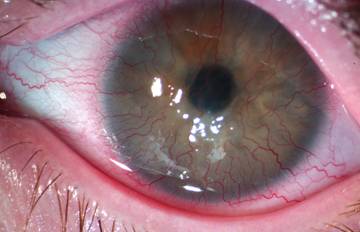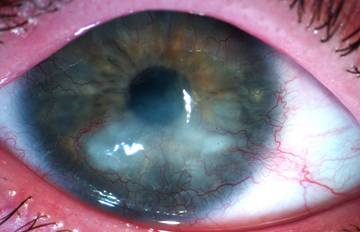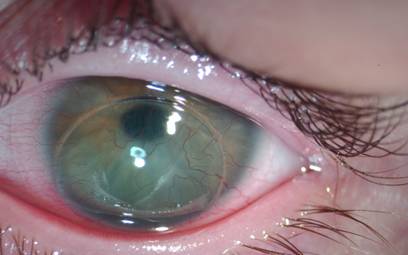|
From time to time we are presented with unusual clinical cases where taking the time to investigate the most appropriate management strategies can result in significant improvements in visual performance and ultimately quality of life for the patient. This is one such case of a 14 year-old female with limbal stem cell insufficiency of unknown cause. She had a normal term birth and no history of chemical injury or trauma, but did have bilateral congenital cataract surgery at 11 months of age. Although not previously a contact lens wearer, she had considerable corneal neovascularization extending to the visual axis in both eyes (Figures 1A and 1B) and best corrected visual acuities of 20/200-3 OD and OS and 20/160+ OU.
 |
Figure 1A: OD |
 |
| Figure 1B: OS |
Although she was using low visual aids, she was open to considering other forms of visual correction in an attempt to improve her level of vision while at school. Cases similar to this are frequently referred for limbal stem cell transplant with penetrating keratoplasty but corneal surgeons are moving away from the limbal stem cell transplant procedure, especially in children. The procedure is actually currently only approved for use in those 18 and older, although it can be performed in special circumstances in younger children. All patients undergoing this surgery must be immunosuppressed for a minimum of 3 years following surgery, using agents such as cyclosporin, Cellcept (mycophenolate mofetil) and prednisone. Unfortunately, there are many complications associated with the use of these agents including diabetes, weight gain, cancer, growth delays, superinfection with opportunistic pathogens, and others [1] In addition, the failure rate of the procedure is close to 40% with frequent corneal melting following taper of the immunosuppressants. For these reasons, surgeons are moving toward using keratoprostheses instead of stem cell transplants, but this course of management is also not without complications.
Until recently, fitting the patient with soft contact lenses would seem counterintuitive since the necessary aphakic prescription would result in very low oxygen transmissibility (Dk/t) and would be expected to only exacerbate the corneal vascularization. This management strategy is now possible however since the recent introduction of custom parameter silicone hydrogel (SiHy) lenses (O2 Optix Custom™, sifilcon A) which have an oxygen permeability (Dk) of 82 . Unfortunately this option is not appropriate in this particular case since the custom SiHy lenses do not correct for this patient’s corneal irregularity which is characteristic of cases of limbal stem cell insufficiency, where corneal thickness overlying a vessels of this nature can result in localized thickening of up to 50 microns.
Our management of choice was to fit the patient with high Dk rigid gas-permeable (RGP) aphakic contact lenses, with a “twist”. We first fitted a low minus SiHy lens (Night and Day™, lotrafilcon A, Dk 140, 8.6/13.8mm -0.50D) lens to each eye in order to reduce mechanical trauma to the already compromised corneas. Mechanical trauma has been shown to decrease corneal keratocyte density and dilate limbal vasculature, presumably stimulating neovascularization in contact lens wearers.[2,3] We then fitted standard design high Dk RGP lenses (Bostonâ XO, hexafocon A, Dk 100, +13.25 OD, +12.00 OS) over the SiHy lenses (Figure 2). Her vision significantly improved to 20/80 OD, 20/100 OS. Although she did report some difficulty in initially adapting to lens wear, she has since built up to 6 hours of wear. While this may seem short, it is sufficient for her to get through most of the day at school which she greatly appreciates. She returns for follow-up assessments for her contact lenses and other low vision aids at 3 monthly intervals and photographs of her corneas are taken at each visit to monitor her condition.
The key to this case was the SiHy component. The RGP lenses alone, although offering the potential for good visual performance and adequate oxygen transmissibility, would have created the potential for a mechanical abrasion that theoretically could have stimulated further neovascularization. This patient was very sensitive to contact lenses in general, but the piggy-back provided superior comfort to the use of RGP lenses alone.
 |
| Figure 2: OD fitted with lotrafilcon B carrier lens and hexafocon A piggyback RGP lens |
References
- Fernandes M, Sangwan VS, Rao SK, Basti S, Sridhar MS, Bansal AK, Dua HS. Limbal stem cell transplantation. Indian J Ophthalmol. 2004 Mar;52(1):5-22. Review.
- Kallinikos P, Efron N. On the etiology of keratocyte loss during contact lens wear.
Invest Ophthalmol Vis Sci. 2004 Sep;45(9):3011-20.
- Dumbleton KA, Chalmers RL, Richter DB, Fonn D. Vascular response to extended wear of hydrogel lenses with high and low oxygen permeability. Optom Vis Sci. 2001 Mar;78(3):147-51.
|